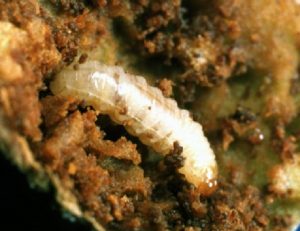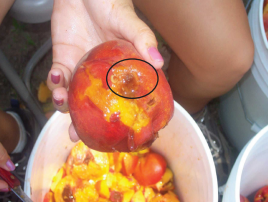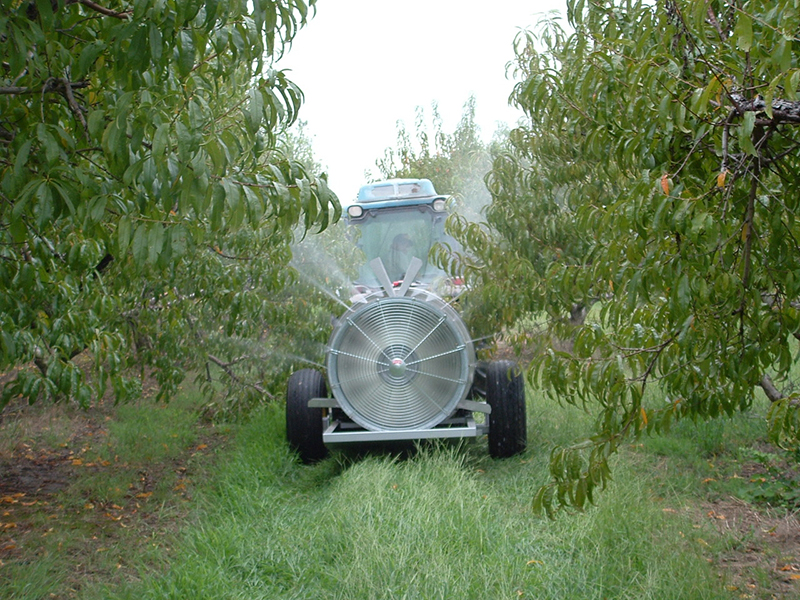Biology and Control of the Plum Curculio in Fruit Trees in Oklahoma
The information contained in this fact sheet deals specifically with biology and control of the plum curculio in Oklahoma. Information on monitoring and trapping plum curculio can be obtained in OSU Fact Sheet EPP-7190. Insecticide recommendations and labeling information are not presented here because they can change dramatically from year to year. That information; however, can be found in OSU Current Report CR-6240.
In fruit trees such as peach or apple, the presence of blooms or fruit availability will greatly influence immigration of plum curculio, Conotrachelus nenuphar. In Oklahoma and throughout the eastern United States, plum curculio is one of the most important insects attacking fruit. In particular, it is extremely detrimental where stone fruits (such as peaches, plums, and apricots) are interplanted with pome fruits (such as apples and pears). The host range of plum curculio includes apple, pear, nectarine, plum, cherry, peach, apricot, and quince. It can also survive on hawthorn, wild plum, and crabapple.
Life Cycle and Biology
The plum curculio exhibits four life stages: egg, larva, pupa, and adult. Eggs are deposited under the skin of the fruit in a small, crescent-shaped cavity (Figure 1). After approximately one week, the eggs hatch into tiny, legless, whitish larvae (Figures 2 and 3). Larvae have distinctive brown head capsules with well-developed mandibles. Fully grown larvae are about ¼ to 3/8 inch in length. There are four larval instars. The pupal stage is spent underground, usually in the upper two inches of soil. The pupa is whitish or cream-colored, measuring about ¼ inch in length and is characterized by having the appendages free from the body and looking like a mummified adult. The adult is a small, rough snout beetle, ¼-inch long and is generally mottled with brown, black, and gray colors (Figure 1). The forewings (elytra) of the beetle have four pairs of ridges, but because the middle humps are the largest, only two parallel ridges are apparent.

Figure 1. Plum curculio adult next to crescent-shaped oviposition scar on peach.

Figure 2. Larval damage by plum curculio on immature peach. Larva is encircled.

Figure 3a.

Figure 3b. Larval stage of the plum curculio showing A) close up of the small larva and large amounts of frass (insect excrement) and B) The larva (encircled) adjacent to bruised area and frass accumulation.
Environmental Influences on Abundance
A complete life cycle, from egg to adult, takes about 50 to 55 days; however, temperature and moisture conditions play a major role in regulating plum curculio development and activity. Weevil adults need water before much activity takes place. In addition, weevils are more active on warm, damp, cloudy days and in thick, heavy stands of trees that provide abundant moisture in the center of the orchard. Curculio activity nearly ceases when temperatures drop below 60° F; however, if temperatures reach 70 to 75 F for two days before petal fall, the weevils may begin to feed and mate.
In the spring, plum curculio adults leave their overwintering quarters (in trash on the ground, woodlots, or hedgerows), and migrate to fruit trees just about bloom time. Migration into the orchard may last up to six weeks after bloom, with the greatest amount of movement occurring within the period up to 14 days after petal fall. Adult weevils do not like strong light and prefer the dense shade of the tree’s inner canopy.
In March, when temperatures reach or exceed 70 F for two days, growers should begin to accumulate degree days within their orchards. A degree-day-based model helps growers time scouting and/or trapping of plum curculio. The model uses a base temperature for weevil development of 50 F. Treatment is justified between 100 and 400 degree days (generally April) if the threshold (0.045 weevils/trap/day) is reached and/or 1 percent of new plum curculio damaged peach fuzz or crescent-shaped feeding wounds are found on peaches. After 1,000 degree days (early June and later), treat if trap captures exceed the same threshold, and repeat spraying at 10-day intervals if trap catch and/or new damage dictates.
Fruit Injury and Damage
Injury from plum curculio is grouped into three classes:
- Crescent-shaped scars on the fruit, caused by egg-laying activity of adults early in the spring, or bumps caused by feeding that protrude from the fruit at harvest. Heavily damaged fruit may be gnarled, knobby, and scarred.
- Internal injury is caused by larvae tunneling throughout the fruit. Most fruit damaged early in the season, in this way will drop to the ground by June (Figure 2). Premature dropping of fruit during May, June, or even later in the season is often the result of larval activity or adult feeding on the fruit. Fruit that remains on the tree may be infested internally and become ravaged by feeding larvae (Figure 3).
- Feeding punctures are made by adult beetles in the fall just prior to overwintering. These punctures are characterized by small holes in the skin of the fruit and may have a hollowed-out cavity extending into the flesh.
In addition to these three direct forms of injury, plum curculio adults can inadvertently infect fruit with spores of brown rot fungus. This occurs during the oviposition (egg-laying) process. Infested fruits usually fall prematurely; however, with some hosts (like cherries or peaches) the fruit can mature with disease infection and remain on the tree until harvest.
Controlling Weevil Populations
Once a threshold has been obtained in an orchard, treatment should be conducted using an airblast sprayer calibrated to deliver a minimum of 40 to 50 gallons per acre (Figure 4). For maximum benefit, many growers will calibrate their sprayers to spray 100 gallons per acre. Airblast sprayers come in a number of sizes. Some larger sprayers can reach the tops of trees in excess of 80 feet and provide excellent coverage to the entire canopy. This may be overkill for fruit trees which do not typically grow to that height. Regardless of insecticide selected, multiple applications will likely be needed throughout the weevil season, especially if fruit are marketed for retail sales. Commercial growers should be encouraged to treat at least two sides of each tree when making pesticide applications; this ensures penetration and thorough coverage. For a complete listing of pesticide recommendations on peaches, including information on fungicides to protect trees from disease infection, consult OSU Current Report CR-6240. This publication is revised each year and contains detailed, current information on chemical recommendations for peaches and nectarines.

Figure 4. Airblast sprayer in peach orchard.
Phillip G. Mulder
Extension Entomologist
